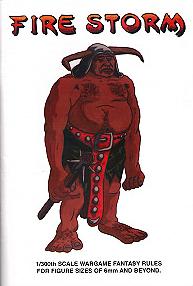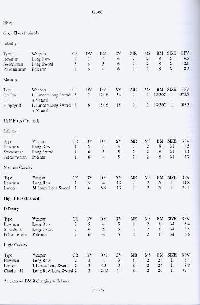
Fire Storm

- Description
- Detailed Description
- Reviews
- Links
Back to FANTASY MASS-COMBAT RULES
In addition to common troops, armies are composed of Individuals and Commanders. Commanders govern companies, brigades, and armies, and issue the orders which allow units to perform actions.
The game is played in a series of Bounds (turns). First, compulsory moves are made (i.e., routs). Then come four Rounds, during each of which a particular type of unit may move/charge, conduct missile fire, and make magical attacks - first Commanders, then Individuals, and then Units. After this, Advance Movement occurs (basically, a travel march phase for units at the fringes of the fighting), then come morale tests for victims of charges, and then melee combats are resolved. The turn ends with morale and other tests.
Individuals and Commanders move within their Round in initiative order (rolled randomly). During the Units Round, however, each Commander may issue one command per phase, up to a maximum limit determined randomly per turn, and subject to units being in range of and assigned to that particular leader.
A unit's movement rate is determined by that troop type's base movement score, the unit's Order (density), its formation (Line, Double Line, Column of Attack, or Column of March), the terrain, the discipline of the unit (trained or untrained), and whether or not it is charging. Rules also cover mounting/dismounting, obstacles, buildings, and weather effects.
Missile fire is limited by arc of fire, range, and limits on the number of ranks which may fire. Both missile and melee combat use the same combat procedure: A dieroll is compared to a chart to determine a score (from +3 to -3), to which is added the target's Defense Value plus any of a series of modifiers (i.e., firing on rear, or firer moved this turn). The final factor is compared on a chart against the number of attackers to determine hits inflicted, which in turn is modified by the troop type's damage modifier and (for missile combat) rate of fire. The final score is deducted from the unit's Stamina value. Once a unit is reduced to less than 50% of original Stamina, it begins to lose figures.
The rules also cover visibility and line of sight, rocks thrown by catapults or Giants, charges, and unit and army morale.
The Advanced Rules add aerial movement/combat, the magic system, Heroes, and the Optional Rules. Heroes differ from Individuals in not being subject to the morale rules, and move in a new round inserted before the Individuals Round. Optional rules include bad weather, night, advance movement, invisibility, herd and pack animals, missile ammunition, uncontrolled movement for certain troop types when out of command, shield wall, pike phalanx, forming square, and cavalry wedges. There are 20 spell classes, each consisting of 5 spells of varying power. A special type of Individual - the Mage - can be purchased. The Mage's Spell Level determines the number and level of spells he possesses, though the spells themselves are assigned randomly.
